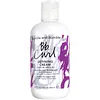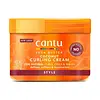Bumble and bumble. Curl Defining Cream Versus Cantu Shea Butter For Natural Hair Coconut Curling Cream
What's inside
What's inside
 Key Ingredients
Key Ingredients

 Benefits
Benefits

 Concerns
Concerns

 Ingredients Side-by-side
Ingredients Side-by-side

Water
Skin ConditioningGlycerin
HumectantCetyl Alcohol
EmollientPetrolatum
EmollientCetearyl Alcohol
EmollientIsopropyl Myristate
EmollientCeteareth-20
CleansingDimethicone
EmollientPersea Gratissima Oil
Skin ConditioningCocos Nucifera Oil
MaskingSimmondsia Chinensis Seed Oil
EmollientTheobroma Cacao Seed Butter
EmollientButyrospermum Parkii Butter
Skin ConditioningGlycine Soja Oil
EmollientTocopherol
AntioxidantMicrocrystalline Wax
Emulsion StabilisingSodium Hyaluronate
HumectantPantethine
EmollientPanthenol
Skin ConditioningSqualane
EmollientOctyldodecyl Citrate Crosspolymer
HumectantSodium PCA
HumectantPhytantriol
HumectantPanthenyl Ethyl Ether
Phenyl Trimethicone
Skin ConditioningPEG-8 Dimethicone
EmulsifyingCetrimonium Chloride
AntimicrobialPvp
Emulsion StabilisingPolyquaternium-7
Butyl Methoxydibenzoylmethane
UV AbsorberEthylhexyl Salicylate
UV AbsorberEthylhexyl Methoxycinnamate
UV AbsorberBHT
AntioxidantParfum
MaskingCitral
PerfumingGeraniol
PerfumingLimonene
PerfumingLinalool
PerfumingChlorphenesin
AntimicrobialSodium Benzoate
MaskingPhenoxyethanol
PreservativeWater, Glycerin, Cetyl Alcohol, Petrolatum, Cetearyl Alcohol, Isopropyl Myristate, Ceteareth-20, Dimethicone, Persea Gratissima Oil, Cocos Nucifera Oil, Simmondsia Chinensis Seed Oil, Theobroma Cacao Seed Butter, Butyrospermum Parkii Butter, Glycine Soja Oil, Tocopherol, Microcrystalline Wax, Sodium Hyaluronate, Pantethine, Panthenol, Squalane, Octyldodecyl Citrate Crosspolymer, Sodium PCA, Phytantriol, Panthenyl Ethyl Ether, Phenyl Trimethicone, PEG-8 Dimethicone, Cetrimonium Chloride, Pvp, Polyquaternium-7, Butyl Methoxydibenzoylmethane, Ethylhexyl Salicylate, Ethylhexyl Methoxycinnamate, BHT, Parfum, Citral, Geraniol, Limonene, Linalool, Chlorphenesin, Sodium Benzoate, Phenoxyethanol
Water
Skin ConditioningCetearyl Alcohol
EmollientCanola Oil
EmollientGlycerin
HumectantCeteareth-20
CleansingParfum
MaskingCeteth-20
CleansingButyrospermum Parkii Butter
Skin ConditioningGlycol Stearate
EmollientPetrolatum
EmollientPEG-75
HumectantPolyquaternium-10
Phenoxyethanol
PreservativeEthylhexylglycerin
Skin ConditioningCocos Nucifera Fruit Extract
EmollientPersea Gratissima Oil
Skin ConditioningPrunus Amygdalus Dulcis Oil
Skin ConditioningSimmondsia Chinensis Seed Oil
EmollientOlea Europaea Fruit Oil
MaskingMangifera Indica Seed Butter
Skin ConditioningArgania Spinosa Kernel Oil
EmollientMelia Azadirachta Seed Oil
EmollientDaucus Carota Sativa Seed Oil
EmollientMacadamia Ternifolia Seed Oil
EmollientMangifera Indica Seed Oil
EmollientGlycine Soja Oil
EmollientVitis Vinifera Seed Oil
EmollientHydrolyzed Silk
HumectantLonicera Caprifolium Flower Extract
PerfumingMacrocystis Pyrifera Extract
Skin ConditioningSalvia Officinalis Leaf Extract
CleansingVitis Vinifera Seed Extract
AntimicrobialUrtica Dioica Extract
AstringentSilk Amino Acids
HumectantAloe Barbadensis Leaf Juice
Skin ConditioningBenzyl Benzoate
AntimicrobialCoumarin
PerfumingHexyl Cinnamal
PerfumingWater, Cetearyl Alcohol, Canola Oil, Glycerin, Ceteareth-20, Parfum, Ceteth-20, Butyrospermum Parkii Butter, Glycol Stearate, Petrolatum, PEG-75, Polyquaternium-10, Phenoxyethanol, Ethylhexylglycerin, Cocos Nucifera Fruit Extract, Persea Gratissima Oil, Prunus Amygdalus Dulcis Oil, Simmondsia Chinensis Seed Oil, Olea Europaea Fruit Oil, Mangifera Indica Seed Butter, Argania Spinosa Kernel Oil, Melia Azadirachta Seed Oil, Daucus Carota Sativa Seed Oil, Macadamia Ternifolia Seed Oil, Mangifera Indica Seed Oil, Glycine Soja Oil, Vitis Vinifera Seed Oil, Hydrolyzed Silk, Lonicera Caprifolium Flower Extract, Macrocystis Pyrifera Extract, Salvia Officinalis Leaf Extract, Vitis Vinifera Seed Extract, Urtica Dioica Extract, Silk Amino Acids, Aloe Barbadensis Leaf Juice, Benzyl Benzoate, Coumarin, Hexyl Cinnamal
 Reviews
Reviews

Ingredients Explained
These ingredients are found in both products.
Ingredients higher up in an ingredient list are typically present in a larger amount.
This ingredient is also known as shea butter. It is an effective skin hydrator and emollient.
Emollients help soothe and soften your skin. It does this by creating a protective film on your skin. This barrier helps trap moisture and keeps your skin hydrated. Emollients may be effective at treating dry or itchy skin.
Shea butter is rich in antioxidants. Antioxidants help fight free-radicals, or molecules that may harm the body. It is also full of fatty acids including stearic acid and linoleic acid. These acids help replenish the skin and keep skin moisturized.
While Shea Butter has an SPF rating of about 3-4, it is not a sunscreen replacement.
Shea butter may not be fungal acne safe. We recommend speaking with a professional if you have any concerns.
Learn more about Butyrospermum Parkii ButterCeteareth-20 is an emulsifier and cleansing agent. It is derived from cetearyl alcohol, a fatty alcohol.
As an emulsifier, Ceteareth-20 prevents oil and water from separating. It is also a surfactant. Surfactants help gather oil, pollution, and dirt to be washed away.
Cetearyl alcohol is a mixture of two fatty alcohols: cetyl alcohol and stearyl alcohol. It is mainly used as an emulsifier. Emulsifiers help prevent the separation of oils and products. Due to its composition, it can also be used to thicken a product or help create foam.
Cetearyl alcohol is an emollient. Emollients help soothe and hydrate the skin by trapping moisture.
Studies show Cetearyl alcohol is non-toxic and non-irritating. The FDA allows products labeled "alcohol-free" to have fatty alcohols.
This ingredient is usually derived from plant oils such as palm, vegetable, or coconut oils. There is debate on whether this ingredient will cause acne.
Due to the fatty acid base, this ingredient may not be Malassezia folliculitis safe.
Learn more about Cetearyl AlcoholGlycerin is already naturally found in your skin. It helps moisturize and protect your skin.
A study from 2016 found glycerin to be more effective as a humectant than AHAs and hyaluronic acid.
As a humectant, it helps the skin stay hydrated by pulling moisture to your skin. The low molecular weight of glycerin allows it to pull moisture into the deeper layers of your skin.
Hydrated skin improves your skin barrier; Your skin barrier helps protect against irritants and bacteria.
Glycerin has also been found to have antimicrobial and antiviral properties. Due to these properties, glycerin is often used in wound and burn treatments.
In cosmetics, glycerin is usually derived from plants such as soybean or palm. However, it can also be sourced from animals, such as tallow or animal fat.
This ingredient is organic, colorless, odorless, and non-toxic.
Glycerin is the name for this ingredient in American English. British English uses Glycerol/Glycerine.
Learn more about GlycerinGlycine Soja Oil comes from the soybean. Glycine Soja is native to eastern Asia.
Soybean oil is an emollient. It is rich in antioxidants and fatty acids including palmitic, stearic, oleic, and linoleic acids.
As an emollient, the fatty acids in soybean oil helps keep your skin soft and hydrated. It does so by creating a film on top that traps moisture in.
Soybean oil is also rich in vitamin E, a potent antioxidant. Vitamin E is also anti-inflammatory and provides a soothing effect.
Studies show soy may help fade hyperpigmentation from UVB. It does so by disrupting the melanin process from UVB induced skin inflammation.
This ingredient may not be malassezia folliculitis, or fungal-acne, safe.
Soybeans are rich in proteins and are part of the legume family. Foods made with soybeans include tofu, soymilk, edamame, miso, and soy sauce.
Learn more about Glycine Soja OilParfum is a catch-all term for an ingredient or more that is used to give a scent to products.
Also called "fragrance", this ingredient can be a blend of hundreds of chemicals or plant oils. This means every product with "fragrance" or "parfum" in the ingredients list is a different mixture.
For instance, Habanolide is a proprietary trade name for a specific aroma chemical. When used as a fragrance ingredient in cosmetics, most aroma chemicals fall under the broad labeling category of “FRAGRANCE” or “PARFUM” according to EU and US regulations.
The term 'parfum' or 'fragrance' is not regulated in many countries. In many cases, it is up to the brand to define this term.
For instance, many brands choose to label themselves as "fragrance-free" because they are not using synthetic fragrances. However, their products may still contain ingredients such as essential oils that are considered a fragrance by INCI standards.
One example is Calendula flower extract. Calendula is an essential oil that still imparts a scent or 'fragrance'.
Depending on the blend, the ingredients in the mixture can cause allergies and sensitivities on the skin. Some ingredients that are known EU allergens include linalool and citronellol.
Parfum can also be used to mask or cover an unpleasant scent.
The bottom line is: not all fragrances/parfum/ingredients are created equally. If you are worried about fragrances, we recommend taking a closer look at an ingredient. And of course, we always recommend speaking with a professional.
Learn more about ParfumPersea Gratissima Oil is also known as avocado oil.
Avocado Oil has antioxidant properties. It is mostly made up of the glycerides of fatty acids. About 67% of these fatty acids is made up of oleic acid. Palmitic acid and linoleic acid are also present.
These fatty acids help hydrate and soften the skin. It may increase collagen content in the skin. Collagen helps keep your skin plump and firm. This ingredient helps reduce inflammation and has not shown to clog pores.
This ingredient may not be fungal-acne safe due to its high fatty acid content.
Avocados also have B vitamins, vitamin K, vitamin C, vitamin E, and potassium.
Learn more about Persea Gratissima OilPetrolatum is more commonly known as petroleum jelly. It is created by mixing waxes and mineral oils.
This ingredient is effective at reducing water loss by 99%. This is because it is an occlusive. Occlusives create a hydrophobic barrier on the skin to prevent evaporation. This property makes it great for hydrating dry skin.
Pro tip: Use occlusives, such as this ingredient, on damp skin for the best results.
The quality or origin of petrolatum is only known when disclosed by the brand. Most cosmetic petrolatum has gone through several purification stages.
Another benefit of occlusives is it protects your skin against infection or allergies.
Petrolatum may not be safe for fungal-acne. Studies show mineral oil / petroleum leads to the growth of M. Furfur, a type of yeast.
Learn more about PetrolatumPhenoxyethanol is a preservative that has germicide, antimicrobial, and aromatic properties. Studies show that phenoxyethanol can prevent microbial growth. By itself, it has a scent that is similar to that of a rose.
It's often used in formulations along with Caprylyl Glycol to preserve the shelf life of products.
This oil comes from the seeds of the desert shrub called Jojoba. It is more commonly known as jojoba oil, a non-comedogenic oil.
Jojoba oil does not contain fragrance and has many fatty-acids, making it a great soothing ingredient.
It also contains Vitamin E, a great moisturizing ingredient. Vitamin E is also an antioxidant and protects your skin against oxidative damage.
This ingredient humectant properties, meaning it helps draw moisture from the air. This helps keep your skin hydrated.
While jojoba has antibacterial properties, it is only able to kill some strains of bacteria.
Studies also show it helps in wound healing. In fact, Indigenous cultures have used jojoba as a moisturizer and to help treat burns for centuries.
Fun fact: Jojoba oil similar to natural human skin sebum, so it has a great effect on dry skin. It is also promising with helping to regulate sebum production.
Due to its fatty acid content, Jojoba oil may not be fungal acne safe. We recommend speaking with a professional if you have any concerns.
Learn more about Simmondsia Chinensis Seed OilWater. It's the most common cosmetic ingredient of all. You'll usually see it at the top of ingredient lists, meaning that it makes up the largest part of the product.
So why is it so popular? Water most often acts as a solvent - this means that it helps dissolve other ingredients into the formulation.
You'll also recognize water as that liquid we all need to stay alive. If you see this, drink a glass of water. Stay hydrated!
Learn more about Water